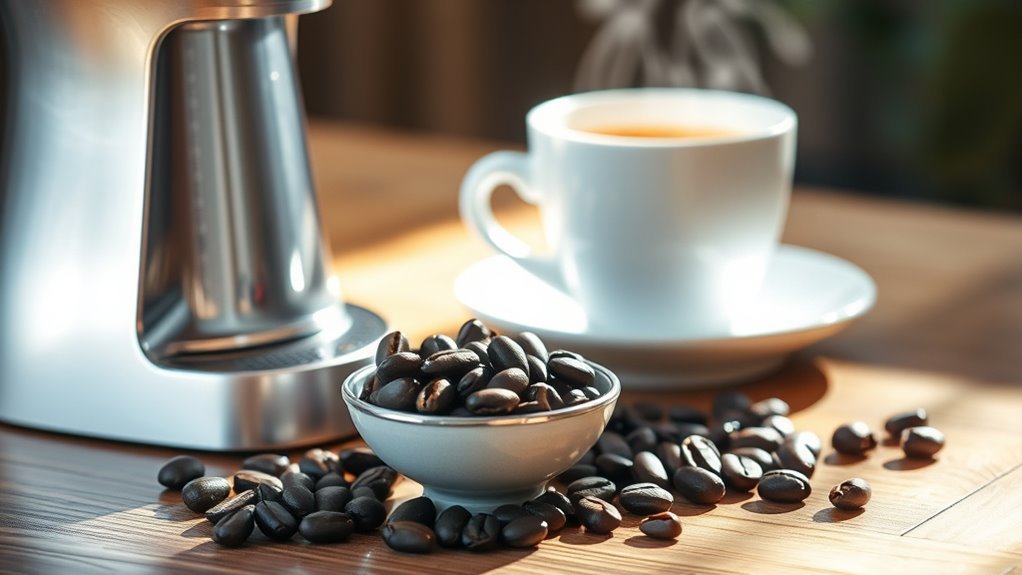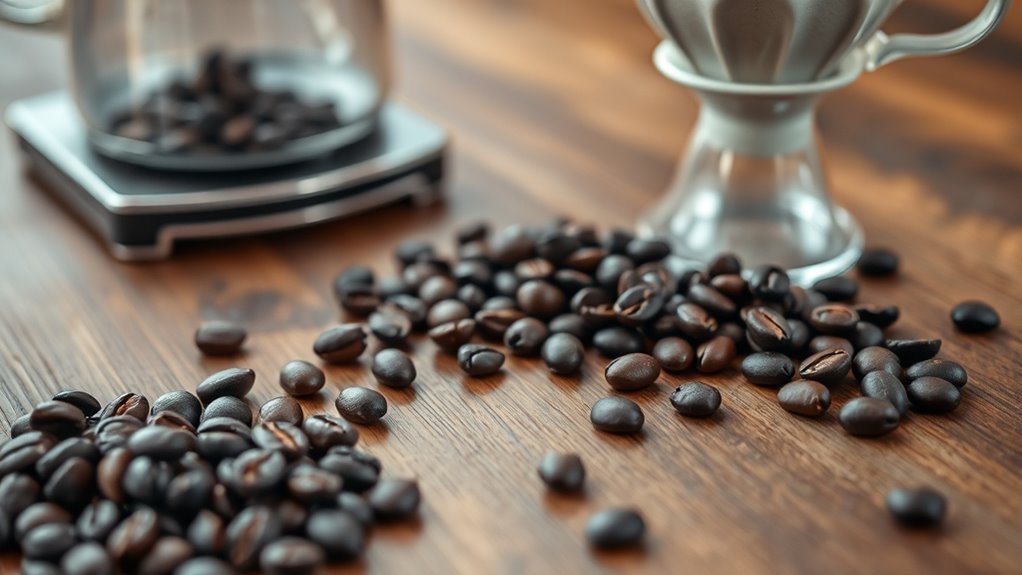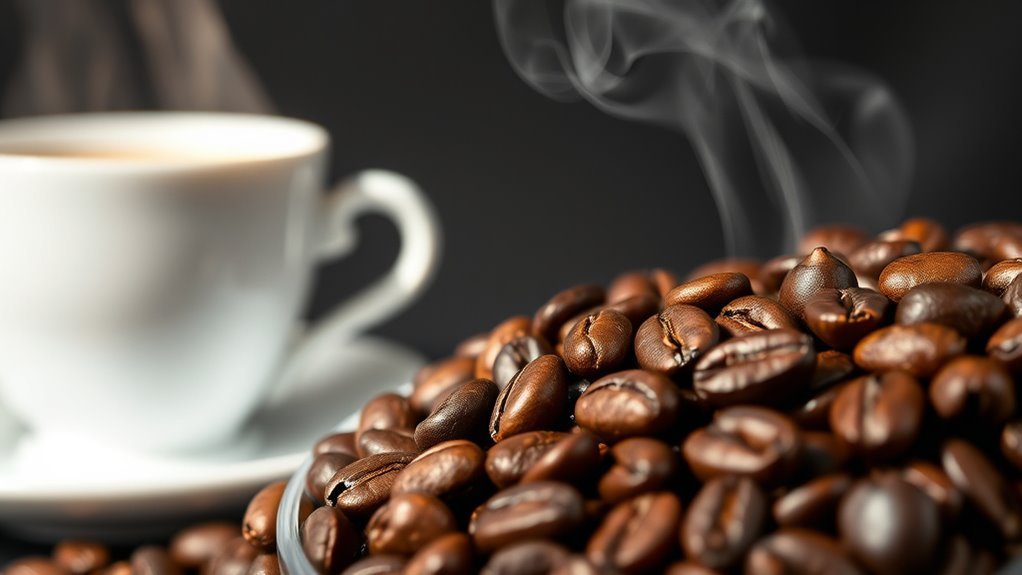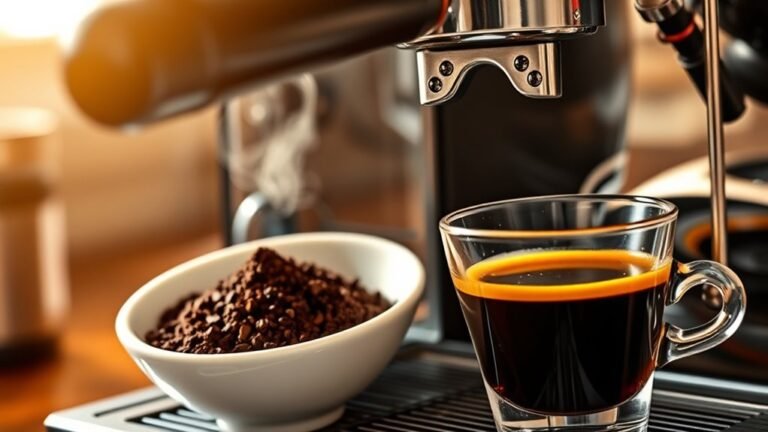Can I Use Espresso Beans for Drip Coffee
Yes, you can use espresso beans for drip coffee, but it’s essential to adjust the grind size for ideal results. Since espresso requires a fine grind, you’ll want to change this to a medium grind for drip brewing to avoid under-extraction or bitterness. The flavor profile of espresso beans brings a rich, intense experience to drip coffee. By making these adjustments and considering brew ratios, you’ll enhance your coffee enjoyment. There’s more to explore on blending and techniques.
Understanding Espresso Beans vs. Regular Coffee Beans

When it comes to coffee, understanding the distinction between espresso beans and regular coffee beans is essential for brewing the perfect cup. Espresso characteristics include a finer grind and a specific roasting profile, often resulting in a bold, concentrated flavor. Regular coffee beans, on the other hand, are typically roasted lighter and ground coarser, which allows for a more balanced taste across various coffee types. This means that while both beans originate from the same plant, their preparation and intended use differ greatly. If you’re seeking a rich, intense flavor, espresso beans might be your choice. However, for a milder, more nuanced experience, regular coffee beans are likely better suited for your brewing needs. Understanding these differences empowers your coffee journey.
The Brewing Process: Espresso vs. Drip Coffee
When comparing the brewing processes of espresso and drip coffee, you’ll notice significant differences in their methods and grind sizes. Espresso requires a fine grind and high pressure, while drip coffee typically uses a coarser grind and relies on gravity for extraction. Understanding these distinctions can help you optimize your brewing technique, whether you’re using espresso beans for drip coffee or not.
Brewing Methods Comparison
Although espresso and drip coffee both originate from the same coffee beans, their brewing processes differ greatly, leading to distinct flavor profiles and experiences. Espresso is brewed under high pressure, forcing hot water through finely-ground coffee, resulting in quick, intense coffee extraction. This method emphasizes rich flavors and a creamy texture. In contrast, drip coffee uses gravity to pass hot water through coarsely-ground coffee over several minutes, allowing for a more gradual extraction that highlights milder flavors. Your brewing preferences ultimately dictate which method you might enjoy more. If you seek boldness and complexity, espresso may suit you. However, if you prefer a more subtle, smoother cup, drip coffee could be your go-to choice. Understanding these differences enhances your coffee journey.
Grind Size Differences
The differences in grind size play a pivotal role in the brewing process of espresso and drip coffee, directly affecting extraction and flavor. For espresso, a fine grind consistency is essential, allowing for quick brew extraction under high pressure. In contrast, drip coffee requires a coarser grind, enabling a slower extraction that’s balanced and smooth.
Consider these factors when choosing your grind:
- Grind consistency: Uniform particle sizes guarantee even extraction.
- Brew time: Espresso brews in 25-30 seconds; drip coffee takes several minutes.
- Flavor profile: A fine grind can lead to bitterness; a coarse grind can result in under-extraction.
- Equipment compatibility: Each grind size suits specific brewing methods effectively.
Understanding these differences can elevate your coffee experience.
Flavor Profiles: What to Expect From Espresso Beans

Espresso beans offer a unique flavor experience that can surprise those accustomed to traditional drip coffee. When you brew with espresso beans, you can expect a heightened flavor intensity that often features bold, rich notes. These beans tend to highlight chocolate, caramel, and nutty undertones, providing a depth that’s less pronounced in standard drip blends. Additionally, the aroma complexity of espresso beans contributes greatly to the overall experience, with fragrant hints that can range from fruity to earthy. This intricate layering of flavors and aromas can create a more stimulating and fulfilling cup, making each sip an exploration of taste. So, if you’re seeking a coffee adventure, using espresso beans in your drip coffee might just be worth a try.
Adjusting Grind Size for Drip Coffee
When using espresso beans for drip coffee, adjusting the grind size is vital for achieving ideal flavor extraction. A finer grind increases the surface area, which can lead to over-extraction if the brewing time isn’t adjusted accordingly. Conversely, a coarser grind may result in under-extraction, so finding the right balance is essential for the best cup.
Grind Size Importance
Grind size plays an essential role in the flavor extraction of drip coffee, influencing both the brewing process and the final taste. Using espresso beans for drip coffee requires careful attention to grind consistency and grind settings. If you want to achieve an ideal brew, consider these factors:
- Coarser grind: Better for drip, allows for balanced extraction.
- Fine grind: Might over-extract, leading to bitterness.
- Grind consistency: Guarantees uniform extraction, enhancing flavor.
- Adjustable settings: Experiment with different grind sizes to find your perfect cup.
Brewing Time Considerations
Although brewing time is often overlooked, it greatly impacts the flavor profile of your drip coffee, particularly when using espresso beans. The grind size plays a significant role here; finer grinds extract faster, which can lead to over-extraction if your brewing time is too long. Conversely, coarser grinds slow down the extraction process, potentially resulting in under-extraction if brewed for too little time. Ideally, you want to aim for a balanced brewing time that allows for peak extraction. For drip coffee, you might need to tweak your brewing time to about 4-6 minutes, depending on the grind size. Experimenting with these variables can help you achieve a flavorful cup that respects your preferences and freedom to enjoy coffee your way.
Brew Ratios: How Much Espresso Beans to Use

Finding the right brew ratio is essential for achieving the perfect cup of drip coffee using espresso beans. The key is to balance brew strength and flavor to suit your taste. Generally, you might start with a ratio of 1:15, meaning one part coffee to fifteen parts water. Adjust according to your preference and desired brew strength. Here are some tips to take into account:
Finding the ideal brew ratio is crucial for a flavorful drip coffee using espresso beans; start with 1:15 and adjust to taste.
- Start with a medium grind for ideal extraction.
- Experiment with different ratios for unique flavor profiles.
- Keep track of your adjustments for consistency.
- Don’t forget to taste and refine your approach.
Tips for Brewing Drip Coffee With Espresso Beans
When brewing drip coffee with espresso beans, it’s essential to pay attention to the brewing process to guarantee peak flavor extraction. Start by adjusting your grind size; a medium grind works best for drip methods, allowing for balanced espresso extraction. You should also experiment with coffee strength by varying the brew time and water temperature. A lower temperature can help avoid over-extraction, which may lead to bitterness. Keep an eye on the coffee-to-water ratio; typically, a 1:15 ratio will give you a delightful cup. Finally, don’t hesitate to tweak these variables based on your taste preferences, as the versatility of espresso beans can lead to a richer and more satisfying drip coffee experience.
Common Mistakes to Avoid

Even with the right techniques in place, it’s easy to make mistakes when brewing drip coffee with espresso beans. Understanding these common pitfalls can help you avoid over extraction issues and guarantee a balanced flavor profile. Here are some mistakes to watch out for:
- Using the wrong grind size: A finer grind can lead to over extraction.
- Ignoring water temperature: Too hot water can cause bitterness and flavor imbalance.
- Skipping the coffee-to-water ratio: Not measuring can result in weak or overly strong coffee.
- Brewing time miscalculations: Over-brewing can intensify undesirable flavors.
Experimenting With Different Blends and Roasts
Exploring various blends and roasts can elevate your drip coffee experience with espresso beans considerably. Flavor experimentation is key when using espresso beans; don’t hesitate to mix different roast combinations. For instance, a medium roast might balance the rich intensity of a dark roast, creating a harmonious cup. Conversely, combining a light roast with a bold espresso can enhance the complexity and brightness of the flavor profile.
Keep in mind that the grind size and brewing time will also affect the final taste, so adjust accordingly as you experiment. By playing with different ratios and types of beans, you’ll discover unique flavors that align with your personal preferences, ultimately giving you the freedom to craft your perfect cup.
Frequently Asked Questions
Can I Mix Espresso Beans With Regular Coffee Beans?
Imagine a symphony of flavors dancing on your palate, where espresso bean blends meet regular coffee beans. You can mix them, creating a harmonious fusion that enhances your coffee flavor profiles. The rich, bold notes of espresso can elevate the lighter, nuanced tones of regular coffee, offering a unique experience. Just remember, balancing the ratios is key; too much espresso might overpower, while too little could leave you longing for that depth. Enjoy experimenting!
Do Espresso Beans Have More Caffeine Than Regular Coffee Beans?
When it comes to caffeine content, espresso beans don’t inherently have more caffeine than regular coffee beans. The difference lies in brewing methods. Espresso is brewed under pressure, extracting more flavors and caffeine per ounce, but the serving size is smaller. If you brewed the same amount of ground coffee from both types, you might find their caffeine levels quite similar. So, it’s not just the beans, but how you brew that matters.
How Long Do Espresso Beans Stay Fresh?
They say, “A stitch in time saves nine,” and that applies to your coffee too. Espresso beans typically stay fresh for about two to four weeks after roasting, but freshness factors like exposure to air, light, and moisture can shorten that lifespan. To maintain their quality, use airtight containers and store them in a cool, dark place. With proper storage methods, you can savor the rich flavors longer and enjoy your coffee experience.
Can I Use Flavored Espresso Beans for Drip Coffee?
Absolutely, you can use flavored espresso beans for drip coffee. The brewing methods might differ, but the essence remains the same. When you use these beans, you’ll infuse your drip coffee with that delightful flavor, enhancing your experience. Just keep in mind that the extraction process varies, which might affect the intensity of the flavor. Experimenting with different ratios can help you find the balance that suits your taste perfectly. Enjoy your brewing!
Are There Specific Brands of Espresso Beans Better for Drip Coffee?
When it comes to choosing espresso beans for drip coffee, think of it like selecting a fine wine for a special dinner. You’ll want brands that enhance your flavor profiles. Consider options like Lavazza or Illy, known for their balanced tastes and smooth finishes. These brands offer a range of flavor profiles that can elevate your brewed experience. Ultimately, it’s about finding what resonates with your palate and brewing preferences.






